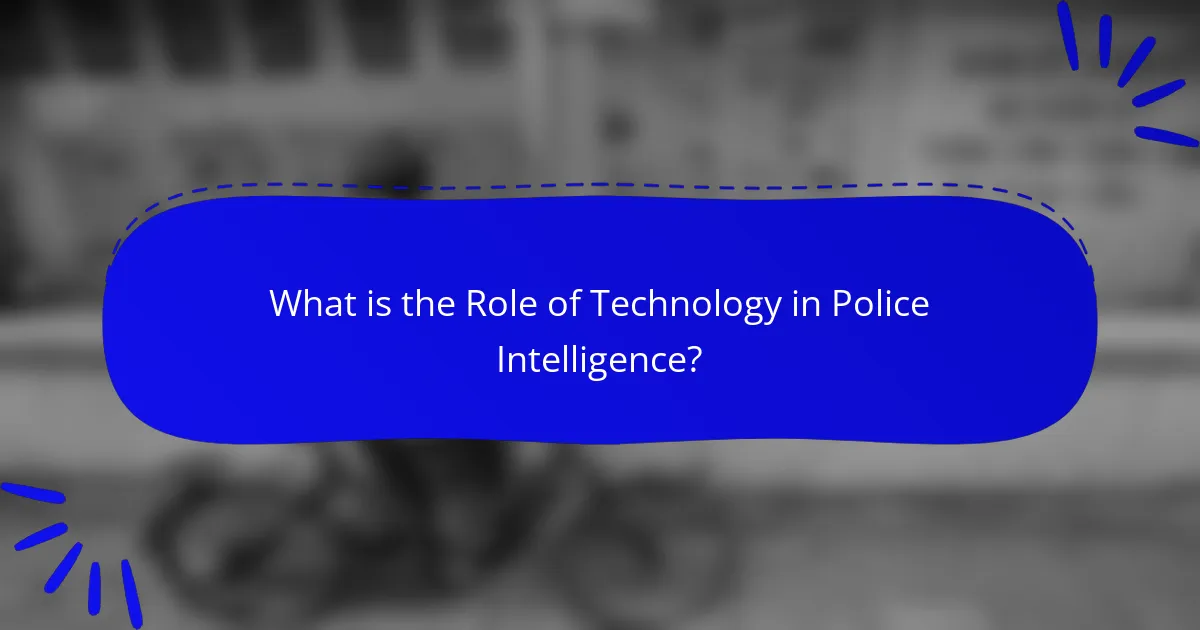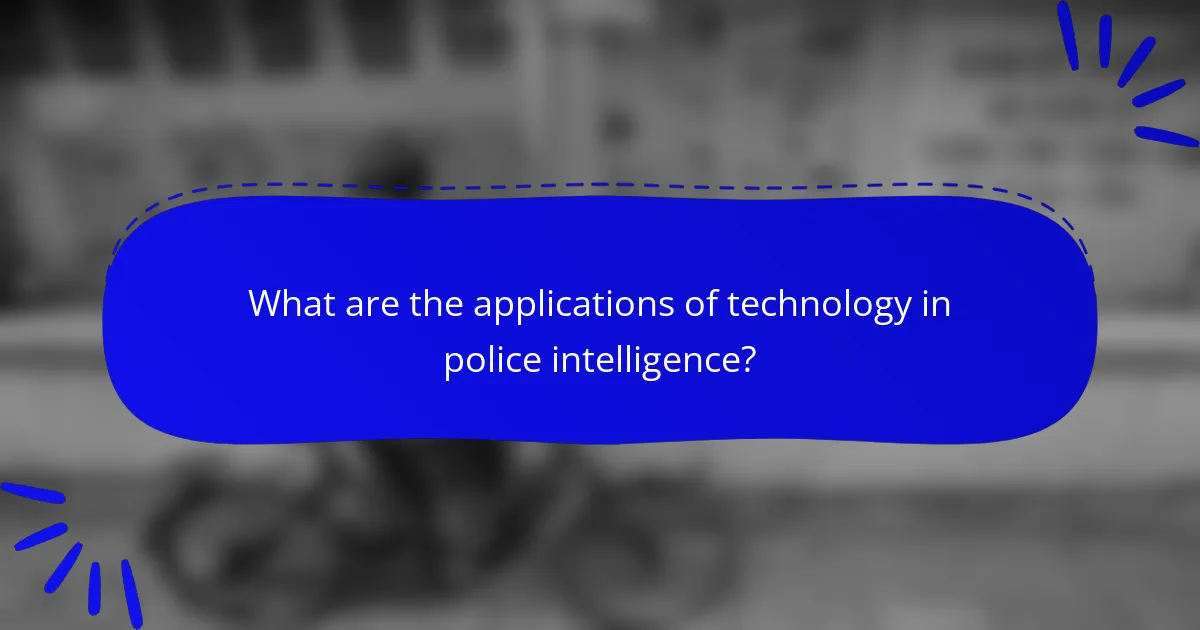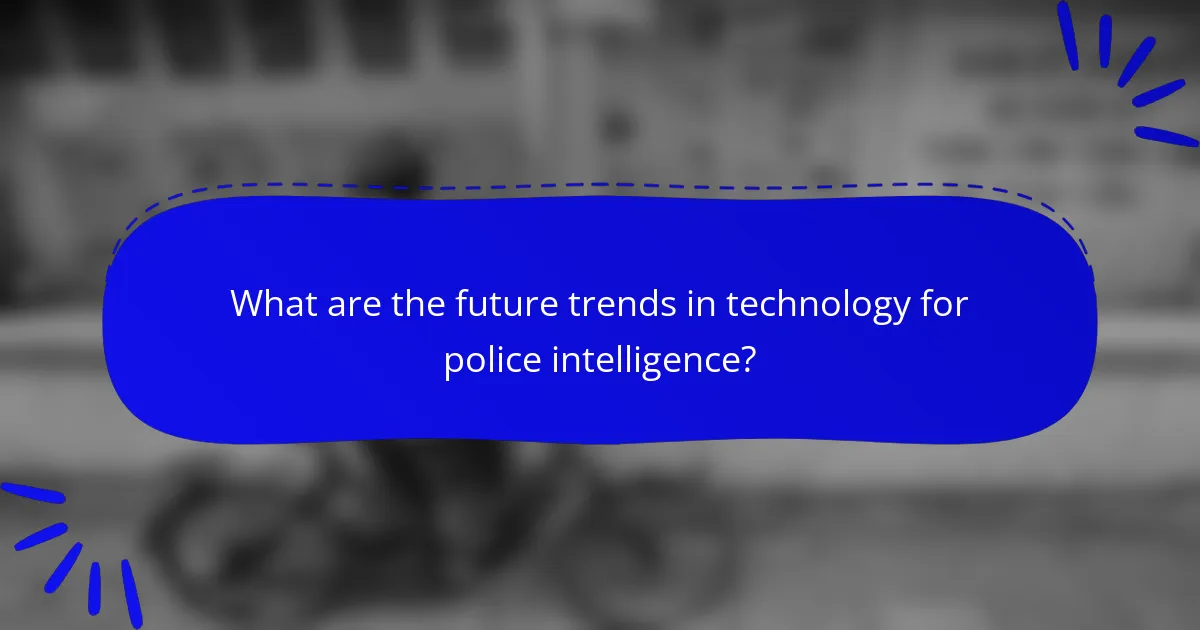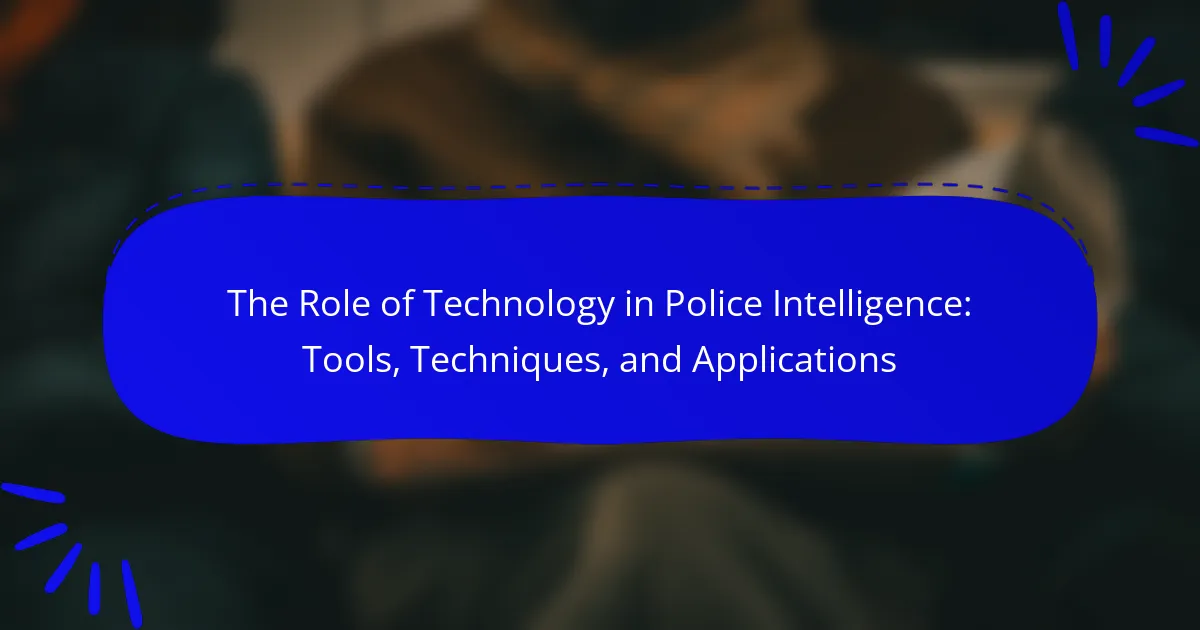
What is the Role of Technology in Police Intelligence?
Technology plays a crucial role in police intelligence by enhancing data collection, analysis, and communication. It enables law enforcement agencies to gather information from various sources, including social media and surveillance systems. Advanced analytics tools facilitate the identification of patterns and trends in criminal activities. Geographic Information Systems (GIS) help visualize crime hotspots and allocate resources effectively. Additionally, technology improves collaboration among agencies through secure communication platforms. For example, the FBI employs the National Crime Information Center to share data across jurisdictions. Overall, technology streamlines operations and supports informed decision-making in police intelligence.
How has technology transformed police intelligence practices?
Technology has significantly transformed police intelligence practices by enhancing data collection, analysis, and communication. Advanced software enables law enforcement to analyze vast amounts of data quickly. This includes crime mapping tools that visualize crime patterns and hotspots. Real-time surveillance technologies, such as body cameras and drones, improve situational awareness. Predictive analytics allows for proactive policing by anticipating criminal activity. Additionally, information-sharing platforms facilitate collaboration among agencies. These innovations lead to more informed decision-making and resource allocation. According to the Bureau of Justice Statistics, agencies using technology report higher efficiency in investigations.
What are the key technologies utilized in modern police intelligence?
Key technologies utilized in modern police intelligence include data analytics, geographic information systems (GIS), and predictive policing software. Data analytics processes large volumes of information to identify patterns and trends in criminal activity. Geographic information systems visualize crime data on maps, aiding in resource allocation and crime prevention strategies. Predictive policing software uses algorithms to forecast potential crime hotspots based on historical data. Additionally, body-worn cameras enhance transparency and accountability in police interactions. Social media monitoring tools assist in gathering intelligence from public platforms. These technologies collectively improve situational awareness and decision-making in law enforcement.
How do these technologies enhance information gathering?
Technologies enhance information gathering by streamlining data collection and analysis. Advanced software allows for real-time data integration from various sources. This includes social media, surveillance systems, and public records. Data analytics tools identify patterns and trends in large datasets. Geographic Information Systems (GIS) visualize crime hotspots effectively. Mobile applications enable officers to access information on the go. Cloud technology facilitates secure data sharing among departments. These innovations improve decision-making and resource allocation in policing.
What are the primary tools used in police intelligence?
The primary tools used in police intelligence include data analysis software, surveillance technology, and communication systems. Data analysis software helps in processing large volumes of information to identify patterns. Surveillance technology, such as cameras and drones, assists in monitoring activities in real-time. Communication systems enable secure sharing of intelligence among law enforcement agencies. Geographic Information Systems (GIS) are also crucial for mapping crime trends. Additionally, forensic tools aid in evidence analysis. These tools collectively enhance situational awareness and decision-making in policing.
What types of software are commonly employed in police investigations?
Types of software commonly employed in police investigations include Computer-Aided Dispatch (CAD) systems, Records Management Systems (RMS), and Crime Analysis software. CAD systems help dispatchers manage calls and resources efficiently. RMS allows officers to record and retrieve incident reports and data. Crime Analysis software assists in identifying patterns and trends in criminal activity. Additionally, Digital Forensics tools are used to recover and analyze digital evidence. Body-Worn Camera (BWC) software manages video data from officers’ cameras. Each of these software types plays a critical role in enhancing police operational efficiency and effectiveness.
How do data analytics tools improve decision-making in law enforcement?
Data analytics tools enhance decision-making in law enforcement by providing actionable insights from vast amounts of data. These tools analyze crime patterns, helping agencies allocate resources effectively. They enable predictive policing by identifying potential crime hotspots. Real-time data analysis supports timely responses to incidents. Additionally, data analytics improves case investigations by uncovering connections between suspects and crimes. Agencies can evaluate the effectiveness of strategies through data-driven assessments. Studies show that jurisdictions using analytics report reduced crime rates and improved community relations. For example, the Chicago Police Department’s use of predictive analytics led to a 30% reduction in shootings.
What techniques are prevalent in police intelligence operations?
Techniques prevalent in police intelligence operations include data analysis, surveillance, and informant networks. Data analysis involves examining large datasets to identify patterns and trends. Surveillance techniques encompass both physical observation and electronic monitoring. Informant networks rely on individuals providing actionable intelligence. Additionally, predictive policing uses algorithms to forecast potential criminal activity. Geospatial analysis maps crime hotspots to allocate resources effectively. Collaboration with other agencies enhances information sharing and operational effectiveness. These techniques collectively improve situational awareness and decision-making in law enforcement.
How is predictive policing implemented through technology?
Predictive policing is implemented through technology by utilizing data analytics and algorithms. Law enforcement agencies collect vast amounts of data from various sources. This data includes crime reports, social media activity, and geographic information. Advanced algorithms analyze this data to identify patterns and trends. These patterns help predict where crimes are likely to occur in the future. Technologies such as machine learning enhance the accuracy of these predictions. Software tools visualize data to assist officers in decision-making. Studies have shown that predictive policing can lead to a reduction in crime rates in certain areas. For example, the Los Angeles Police Department reported a 12% decrease in property crimes after implementing predictive policing technology.
What role does surveillance technology play in intelligence gathering?
Surveillance technology plays a crucial role in intelligence gathering by enabling the collection of real-time data. This technology includes cameras, drones, and electronic monitoring systems. These tools allow law enforcement agencies to observe and track suspects effectively. For example, closed-circuit television (CCTV) systems can capture footage of criminal activities. Drones provide aerial surveillance, covering large areas quickly.
According to a report by the Bureau of Justice Statistics, 60% of law enforcement agencies use video surveillance as a tool for crime prevention. Surveillance technology enhances situational awareness and supports decision-making in real-time. It also aids in the analysis of patterns and behaviors linked to criminal activities. Overall, surveillance technology is a fundamental asset in modern intelligence gathering for police forces.
How do police agencies integrate technology into their operations?
Police agencies integrate technology into their operations through various advanced tools and systems. They use computer-aided dispatch (CAD) systems for efficient call management. Body-worn cameras enhance accountability and provide evidence during interactions. Data analytics software helps in crime pattern analysis and resource allocation. Geographic Information Systems (GIS) assist in mapping crime hotspots. Drones are utilized for surveillance and monitoring large areas. Social media platforms are leveraged for public engagement and information gathering. Cybersecurity measures protect sensitive data from breaches. These integrations improve operational efficiency and enhance public safety.
What challenges do law enforcement agencies face in adopting new technologies?
Law enforcement agencies face several challenges in adopting new technologies. These challenges include budget constraints that limit the ability to invest in advanced systems. Training personnel to effectively use new technology is another significant hurdle. Many officers may resist change due to a lack of familiarity with modern tools. Integration with existing systems can also prove difficult, leading to interoperability issues. Additionally, concerns over privacy and civil liberties can hinder the implementation of surveillance technologies. Compliance with regulations and legal standards further complicates the adoption process. Lastly, the rapid pace of technological advancement can lead to obsolescence before full deployment.

What are the applications of technology in police intelligence?
Technology in police intelligence includes applications such as data analytics, surveillance systems, and communication tools. Data analytics helps in processing vast amounts of information to identify crime patterns. Surveillance systems, including CCTV and drones, assist in monitoring public spaces for suspicious activities. Communication tools facilitate real-time information sharing among law enforcement agencies. Geographic Information Systems (GIS) aid in mapping crime locations and trends. Predictive policing software analyzes data to forecast potential criminal activities. Social media monitoring tools track public sentiment and potential threats. Lastly, biometric technologies enhance identification processes, improving suspect recognition and evidence collection.
How is technology used in crime analysis and prevention?
Technology is utilized in crime analysis and prevention through various tools and techniques. Data analytics software processes large volumes of crime data. Geographic Information Systems (GIS) help visualize crime patterns on maps. Predictive policing algorithms forecast potential crime hotspots based on historical data. Surveillance technology, including cameras and drones, enhances situational awareness. Social media monitoring tools track criminal activity and public sentiment. Mobile applications facilitate real-time reporting of crimes by citizens. These technologies contribute to more informed decision-making in law enforcement. Research indicates that jurisdictions employing these technologies report reductions in crime rates.
What impact does technology have on community policing efforts?
Technology enhances community policing efforts by improving communication and data sharing. It facilitates real-time information exchange between law enforcement and community members. Tools such as social media platforms allow police to engage with citizens directly. This engagement fosters trust and transparency, which are vital for effective policing. Additionally, data analytics helps identify crime patterns and hotspots. This information enables proactive policing strategies. For instance, a study by the Police Executive Research Forum found that technology integration leads to a 20% reduction in crime rates in communities. Overall, technology significantly strengthens the relationship between police and the community.
How does technology facilitate inter-agency collaboration?
Technology facilitates inter-agency collaboration by enabling real-time communication and data sharing. It provides platforms such as secure messaging systems and cloud-based databases. These tools allow agencies to access and exchange critical information quickly. For instance, law enforcement agencies can share intelligence on criminal activities instantly. This rapid information flow enhances situational awareness and decision-making. Additionally, technology supports joint operations through coordinated planning tools. According to a study by the International Association of Chiefs of Police, technology improves operational efficiency in multi-agency efforts. Overall, technology streamlines processes and fosters stronger partnerships among agencies.
What are the ethical considerations surrounding technology in police intelligence?
Ethical considerations surrounding technology in police intelligence include privacy, accountability, and bias. Technology can infringe on individuals’ privacy rights. Surveillance tools often collect data without consent, raising ethical concerns. Accountability is crucial when technology is used for policing. Officers must be responsible for the use of these tools. Bias in algorithms can lead to discriminatory practices. Studies have shown that [censured] recognition technology can misidentify individuals, particularly people of color. Transparency in technology deployment is necessary to build public trust. Ethical guidelines must be established to govern the use of technology in police intelligence.
How do privacy concerns affect the implementation of surveillance technologies?
Privacy concerns significantly hinder the implementation of surveillance technologies. These concerns lead to public resistance against invasive monitoring systems. Citizens often fear misuse of their personal data. Legal frameworks may impose strict regulations on data collection and storage. Compliance with privacy laws can increase operational costs for law enforcement agencies. Additionally, transparency in surveillance practices is demanded by the public. This demand can slow down the deployment of new technologies. Research indicates that jurisdictions with strong privacy protections often experience delays in adopting surveillance tools. For instance, a report by the Electronic Frontier Foundation highlights cases where privacy laws have restricted technology use in policing.
What measures are in place to ensure accountability in technology use?
Measures to ensure accountability in technology use include strict data governance policies. These policies outline how data is collected, stored, and used. Regular audits are conducted to assess compliance with these policies. Transparency in technology deployment is also crucial. This involves clear communication about technology capabilities and limitations. Training programs for law enforcement personnel are implemented to promote ethical usage. Additionally, oversight bodies monitor technology applications to prevent misuse. Public reporting of technology use and its outcomes fosters trust and accountability. These measures help maintain integrity in police intelligence operations.

What are the future trends in technology for police intelligence?
Future trends in technology for police intelligence include advanced data analytics, artificial intelligence, and predictive policing. Data analytics will enhance the ability to process large volumes of information quickly. AI algorithms will assist in identifying patterns and anomalies in criminal behavior. Predictive policing aims to anticipate crimes before they occur by analyzing historical data. Body-worn cameras will improve accountability and transparency in law enforcement. Drones will provide aerial surveillance capabilities for crime scene analysis. Cybersecurity technologies will protect sensitive data from breaches. Integrated communication systems will facilitate real-time information sharing among agencies. These trends are supported by ongoing investments in technology by law enforcement agencies globally.
How will artificial intelligence shape the future of police intelligence?
Artificial intelligence will significantly enhance police intelligence through improved data analysis and predictive policing. AI algorithms can analyze vast amounts of data quickly, identifying patterns and trends that human analysts might miss. For instance, AI can process crime reports, social media activity, and surveillance footage to generate actionable insights. Predictive policing tools, such as those developed by PredPol, use historical crime data to forecast potential crime hotspots. This approach has been shown to reduce crime rates in several pilot programs by enabling proactive law enforcement. Additionally, AI-powered [censured] recognition technology assists in identifying suspects more efficiently. The integration of AI in police intelligence leads to more informed decision-making and resource allocation.
What emerging technologies are expected to influence law enforcement practices?
Emerging technologies expected to influence law enforcement practices include artificial intelligence, drones, and body-worn cameras. Artificial intelligence enhances data analysis and predictive policing. Drones provide aerial surveillance capabilities for crime scene monitoring. Body-worn cameras promote accountability and transparency during police interactions. Additionally, [censured] recognition technology aids in identifying suspects. These technologies are being adopted to improve efficiency and effectiveness in law enforcement. For instance, a report from the National Institute of Justice highlights AI’s role in crime forecasting.
What best practices should police agencies follow when adopting new technologies?
Police agencies should follow several best practices when adopting new technologies. First, they must conduct thorough needs assessments to identify specific operational requirements. This ensures that the technology aligns with their goals. Second, agencies should engage stakeholders, including community members, to gather diverse perspectives. This fosters transparency and builds trust. Third, comprehensive training programs are essential for personnel to effectively utilize new tools. Training enhances user competency and reduces resistance to change. Fourth, agencies must establish clear policies and procedures to govern technology use. This includes guidelines for data privacy and security. Fifth, ongoing evaluation and feedback mechanisms should be implemented. Continuous assessment allows for adjustments based on performance and user experience. Lastly, collaboration with other agencies can enhance resource sharing and best practice development. These practices are supported by research from the International Association of Chiefs of Police, which emphasizes the importance of strategic planning and community engagement in technology adoption.
The primary entity of the article is technology in police intelligence. The article provides a comprehensive overview of how technology enhances data collection, analysis, and communication within law enforcement agencies. It discusses key tools such as data analytics, Geographic Information Systems (GIS), and surveillance technologies, as well as their applications in crime analysis and prevention. Additionally, the article addresses the challenges law enforcement faces in adopting new technologies, ethical considerations, and future trends shaping police intelligence practices. Overall, it highlights the critical role of technology in improving operational efficiency and decision-making in policing.
